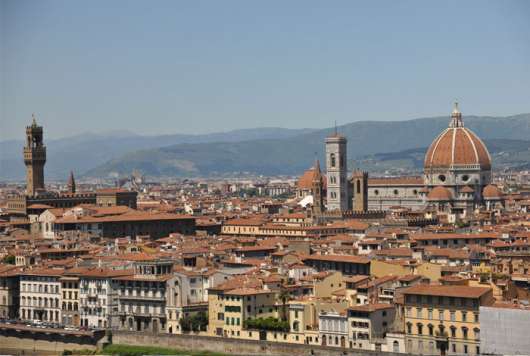Historic Cities
We created these pages to help you really Discover Italy. Journalists Donald Strachan, Steve Keenan and Jasmine Boni Ball — who visit several times every year — have gathered a rich crop of local stories and written destination guides to help you make the most of your vacation. As they say in Italy, “Buon viaggio!”
Florence
For two centuries, the arts thrived in Florence like never before. Under the patronage of the Medici and others, this was the centre of the Western world in the 1400s and 1500s. The legacy of the Renaissance is preserved on the walls of the Uffizi Gallery, in the corridors of the Palazzo Vecchio, on the domed roof of the Duomo, and in churches like Santa Croce and Santa Maria Novella.
Padua
Just 40km east of Venice, Padua is often overshadowed by its famous neighbour, but this vibrant university town has a rich artistic, literary, scientific and religious heritage of its own. Amble alongside the 13th century canal or wander the arcaded streets and elegant piazzas lined with shops and trattorias in the city’s historic centre.
Mantua
Surrounded by three lakes, the ancient city of Mantua seems to rise out of the water. It has a rich artistic and cultural past; the birthplace of poet Virgil and once a Renaissance power that boasted one of the finest courts in Europe. It has hosted famous artists from Leonardo di Vinci to Raphael. Visit grand piazzas, landscaped gardens and the city’s own Ducale Palace.
Verona
Tourists inspired by Shakespeare’s star-crossed lovers flock to take in the romance of Verona. But beyond this Renaissance charm is a thriving city with a turbulent history and medieval roots. It is rich in Roman remains as well as Romanesque and Gothic architecture built in Veronese pink stone. The remarkable 1st century Roman amphitheatre hosts one of Italy’s most renowned opera festivals throughout the summer months each year.
Venice
Venice, ‘La Serenissima’, is one of the most talked and written about, venerated and immortalised places on earth. It is a masterpiece of architecture and engineering, boasting some of Italy’s finest artists from Titian and Tintoretto to Veronese and Bellini. It is the floating city of grand doges, winged lions, serenading gondoliers, Murano glass and the unmissable Byzantine façade of the Basillica di San Marco.
Siena
A time-traveller from medieval Tuscany could probably still find their way around Siena. This steep winding streets of its small city centre are stuffed with Gothic palaces, ethereal art and locals who love their sweet treats. At its heart is the Campo, one of Europe’s most photogenic squares and twice each summer host to the Palio horserace.
Pisa
A building spree in the 12th century left Pisa with a famous legacy. On the edge of its flat centre is a grassy field that's also Italy’s most extraordinary piazza — deserving of its nickname: the Campo dei Miracoli, “Field of Miracles”, complete with a Leaning Tower. Gothic art and historic botanical gardens are also right in the heart of the city.
Lucca
Puccini's home city has some of Tuscany’s most elegant streets. Lucca's churches including San Michele have towering facades with ornate, multi-storey arcades. Its museums exhibit everything from Etruscan archaeology to baroque portraits. And the best way to see it all? By bike.
Rome
You would need a lifetime to explore every corner of Italy’s capital, aka the Eternal City. The giant dome of St. Peter’s marks one of Europe’s most recognizable skylines. This is a city of Roman Emperors and Popes, and artists such as Michelangelo, Caravaggio, and Bernini, and stuffed with sights, museums, ruins and restaurants where you can eat alla romana.
Perugia
Discover Umbria’s hilltop capital and birthplace of the world’s most romantic chocolate, Baci Perugina. There’s plenty more hiding underneath Perugia, literally — there is a subterranean medieval city to be discovered. Get your groove on at Umbria Jazz, and your chocolate fix at the annual Eurochocolate festival.
Grosseto
The old centre of the Maremma's only real city is wrapped in ramparts built by the Medici Grand Dukes after they kicked out the Sienese in 1559. Inside Grosseto's walls, you can explore a pretty square, a 13th-century cathedral and one of Tuscany's best Etruscan museums. Beaches and ancient archaeology are nearby.
Orvieto
This tight-packed city is raised high above the Tiber Valley on a sheer turret of volcanic tufa rock. Once you’ve ridden the funicular to the top — much more fun than driving — you’ll find a maze of medieval streets and the "Golden Lily of Cathedrals", one of the great buildings of central Italy. While you're here, you can shop for Orvieto Classico wine and painted majolica ceramics.
Livorno
Tuscany’s largest port and second-largest city, after Florence, is a place of pilgrimage for seafood lovers. The city’s signature dish is “cacciucco”, a spicy soup-stew made with whatever fishermen plucked from the sea that morning — a little like Marseille’s bouillabaisse. Livorno's restaurants are legendary, plus there's 17th-century naval fortifications, 19th-century impressionist art and literary heritage to discover.












